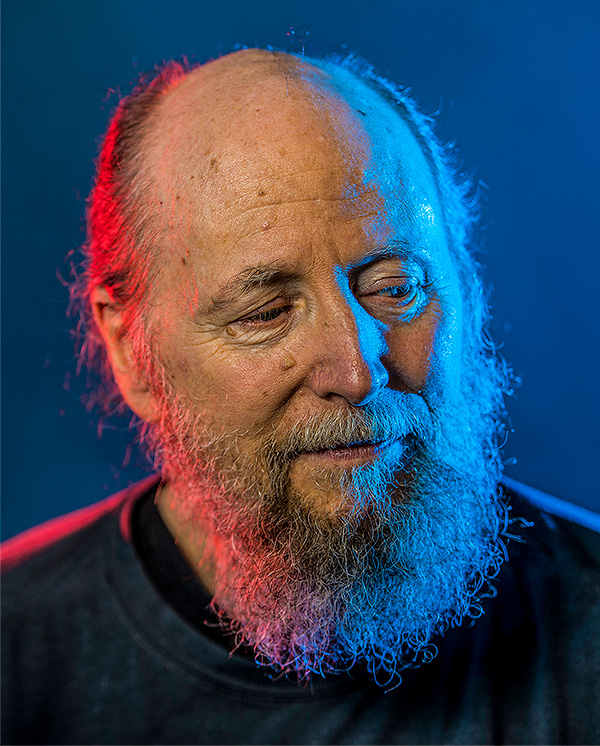A U of A grad has a hand in helping Avatar take home an Academy Award for Best Art Direction
[Editor's Note: This story originally appeared in the Spring/Summer 2010 issue of New Trail. On February 27, 2011, Alice in Wonderland-for which Cherniawsky was an art director-also won an Oscar for Best Art Direction.]
Perhaps if Todd Cherniawsky, '93 BFA, had been a little more focused it all would have played out very differently. He would still have gone to NAIT for his Architectural Technology diploma and then moved on to the U of A's industrial design program. But after that he would have packed up his belongings and moved to Denmark. "Seriously," he says, "when I first started at the U of A in industrial design I wanted to move to Denmark and work as a designer for Lego."
But sometimes, as the old song goes, you can't always get what you want. So instead of Copenhagen it was Los Angeles and instead of Lego it was an MFA in production design at the American Film Institute - financed, in part, by two Alberta Heritage Fund scholarships in back-to-back years.
Armed with his education and considerable ability, it didn't take Cherniawsky long to begin getting work as a set designer, working on such films and with such directors as Michael Bay (Armageddon), Barry Levinson (Sphere), Ang Lee (The Hulk), Robert Zemeckis (The Polar Express), Steven Soderbergh (Ocean's 13) and Brad Siberling (Lemony Snicket's A Series of Unfortunate Events). He was also assistant art director for Stephen Spielberg's War of the Worlds and was set designer for Tim Burton's version of Planet of the Apes. He recently teamed up with Burton again as the art director of the delicious-looking Alice in Wonderland.
An Amplified Mobility Platform (AMP) suit, a combat vehicle Todd Cherniawsky helped design that is worn and controlled as a large motorized suit. A suit similar to this-minus the armaments-was seen in Aliens, a film directed by James Cameron.
That's a pretty impressive catalogue of A-list directors Cherniawsky's worked for, even without adding James Cameron to the roster. Yeah, that guy, the Canadian director responsible for the two highest grossing films of all time: Titanic and Avatar. Cameron may like his film titles small, but he sure likes his movies big. And he also likes working with Cherniawsky, who worked for Cameron on Ghosts of the Abyss, Disney's first 3-D film, before becoming an art director on Avatar.
Although Avatar didn't win the Academy Award for best picture, it did win in the art direction category, as well as for visual effects and cinematography. The people singled out in the art direction category on Awards night were Rick Carter, Robert Stromberg and Kim Sinclair. Cherniawsky refers to Carter (Jurassic Park, Forrest Gump) as his mentor. And as to what difference his having a hand in Avatar winning an Oscar for art direction will make in his life, he said on the Monday following the film's win, "No difference. I'm just as unemployed now as I was on Friday. Just kidding. It's been a nice run of work, and now I'm taking some time off."
We won't know until next year if Burton's wonderfully inventive Alice in Wonderland will win an Academy Award for art direction, but it's near certain to be nominated in this category. Cherniawsky helped create the entire digital environment for Alice, beginning his research of how that world would look by studying art history books and even exploring how the natural and supernatural worlds were perceived in 19th-century England, when Lewis Carroll wrote the original book.
Although Alice presented its own design challenges, they paled in comparison to what was required for Avatar. Cherniawsky was originally hired for that film as an assistant art director in charge of designing the control room for the mining operation on Pandora, the imaginary planet in the movie on which the native Na'vi people battle the rapacious earthlings who will stop at nothing to obtain the precious mineral unobtanium that, unfortunately, lies beneath some sacred Na'vi real estate. His role expanded to being one of the supervising art directors. He was responsible for the design of the air and ground vehicles in the film, and getting the people under his supervision - up to 30 depending on the phase of the movie - focused on realizing Cameron's vision of what those vehicles should look, feel and perform like.
That wasn't the easiest of tasks because not only is Cameron one of the film industry's premier production designers in his own right, but, Cherniawsky says reflectively, "Jim has been to Pandora." Of course, Pandora is a non-existent planet, but to Cameron it was so real that he had "seen" everything he tasked others with making reality.
Many have labeled Cameron - justly or unjustly - as someone who is a tad difficult to work with. Kate Winslet, who worked with him on Titanic, said, "There were times when I was genuinely frightened of him. Jim has a temper like you wouldn't believe." Cameron hasn't helped matters much by saying such things as, "Torturing crews and actors? That's my job." And, "I don't love pain. I love results, and sometimes results require pain."
So what was Cherniawsky's experience working with the notoriously uncompromising director during "never-shorter-than-12-hour days" on the set over a period of 19 months? "Oh, Jim," he begins slowly. "I don't feel the stories and myths about how tyrannical he is are fair. He expects 100 percent every moment of the day. He's a perpetual motion machine, very intense. He just works hard - a transplanted Canadian with a good work ethic. Working with Jim is like taking a master class in film-making. He also doesn't have any problem communicating ideas, and he's a good art director and drawer himself. He helped keep us on track as to where we needed to end up once the designing process began."
Colonel Miles Quaritch (Stephen Lang) in a heavily armed C-21 Dragon Assault Ship, which can deliver troops and AMP suits. "The assault ship," Cherniawsky says, "was actually built full-sized and moved around by a crane."
For Cherniawsky, that designing process began in the library. "Going on the Internet is all fine and good," he says, "but you need to look through 12-pound books and digest the stuff. I knew immediately the level of detail Jim was expecting would be pretty prominent. And since my focus was on the vehicles, I spent the better part of two months visiting aircraft manufacturers looking at what's out there and what's coming. And I also spent a few days on the phone talking to other U of A alumni - engineers who talked me through some large-scale mining operations."
To ensure all the vehicles looked like they could actually be operated in the fictional environment in which they were supposedly functioning, Cherniawsky made sure the vehicles didn't look like they were fabricated from expensive and exotic materials and that they appeared sturdy and rugged so they could take a beating and continue in operation.
"All of this ends up informing the look of the vehicles," he says. "The fact that they look like vehicles already used in wars is because of the research. I also had to keep in mind the fact that it would cost a couple million dollars to send one pound of material to Pandora."
Cherniawsky with the AT-99 Scorpion Gunship he designed-it's wrapped up for transport to Pandora aboard the Interstellar Vehicle Starbulk carrier that remains in orbit around Pandora while Valkyrie shuttlecraft that dock with it transport supplies and equipment to the planet's surface.
Which brings us back to Cameron, who had not only mentally been to Pandora, but he also started out in the film business as a model builder before quickly progressing into production design, which, as he says, "made sense because I could draw and paint." All pretty daunting for Cherniawsky. There was, in fact, one occasion when Cherniawsky's team took the Vietnam War-era look of the war machines in the film way too far, prompting Cameron to reproach, "Last time I looked, I thought this was a sci-fi film."
It was another sci-fi film that Cherniawsky remembers seeing that really got him jazzed about the genre - 2001: A Space Odyssey (that same movie inspired Cameron, who saw it when he was 14, to want to make his own films). "I didn't care what else was on TV," Cherniawsky says. "Just the movies. And as a kid, when I did go to the movies, I'd walk out of the movie theatre and think 'Wow, wouldn't it be great to be able to do that,' but dismissing it immediately." Over time that attitude obviously changed.
It was while he was at the U of A that Cherniawsky began to think seriously about a film career. "The U of A was a great grounding platform where I could explore all sorts of things that would come in handy later on," he says. "It's hard for me to imagine any of the following film steps taking place without that U of A step. It covers a lot of ground and nothing is useless down the road.
"Oh dear! Oh Dear! I shall be too late!" The White Rabbit (that Alice follows down the rabbit hole) and Alice in Tim Burton's Alice in Wonderland.
Once he got to the U of A, Cherniawsky also found his initial foray into architecture broadening out to encompass a much wider umbrella of design and other aspects of art, literature and science. "I was able to sample theatre design," he says. "I was able to take graphic design, I was able to take some painting and some sculpture. I was also able to take comparative literature, some engineering, some statistics. All of a sudden I was rounding out a background to become a production designer - without even knowing it."
Although he's been there before - with the low-budget cult classic werewolf film Ginger Snaps (under $5 million) and the higher-budget (over $24 million) Splice - Cherniawsky is now set on waiting for the phone to ring with an offer to oversee an entire art department as the production designer. "I have a chance now to make the move into production design," he says. "So right now I'm turning down art direction jobs while I wait for however long it takes for an offer to do production design.
"As I said, the U of A was instrumental in helping to make that possible. For instance, I took a history of science course that I thought would be tolerable. But when I started working on Planet of the Apes, one scene cut out of the final film was a medieval laboratory. All of my information for creating the look of that scene came from the grounding of that course. And taking cultural anthropology at the U of A helped me understand the Na'vi in Avatar. As well, most of the teachers and professors I had were more like mentors. I felt like I was in very good hands with them in that they not only taught me but educated me as to how I could teach myself down the road."
While at the U of A Cherniawsky used the architectural drawing skills he'd acquired at NAIT to make money drawing for architects. He also taught skiing, something he really misses easy access to in his adopted city of Los Angeles. "As a kid, all I wanted to do was make the Canadian ski team," says Cherniawsky, who was brought up on an acreage outside of Ardrossan, AB. "But I just wasn't strong enough. Technically I was good, but I didn't have the strength."
Although he misses the snow somewhat, he says, "Not having it around on a day-to-day basis is pretty good as well. My wife's from the Lake Tahoe area, so I get a couple weeks on snow every year." And as for his obsession with Lego, nothing much has changed. Although he may not be working for the company, he still goes back to his roots on a regular basis.
"To this day I've remained a Legomaniac," he laughs. "There is a Legoland down here, and there's this Lego store where you can buy things by the pound."
Clearly someone should be contacting him to discuss his participation in Lego: The Movie. I kid you not. Warner Bros. is actually planning a film of that name in association with the Danish toy manufacturer. Maybe, just maybe he'll get that call he's waiting for.






























































































































































































































































































































































































































































We at New Trail welcome your comments. Robust debate and criticism are encouraged, provided it is respectful. We reserve the right to reject comments, images or links that attack ethnicity, nationality, religion, gender or sexual orientation; that include offensive language, threats, spam; are fraudulent or defamatory; infringe on copyright or trademarks; and that just generally aren’t very nice. Discussion is monitored and violation of these guidelines will result in comments being disabled.